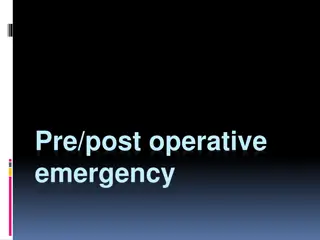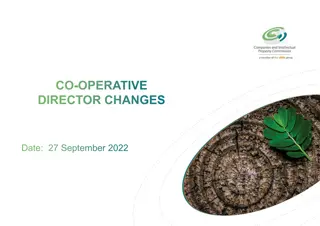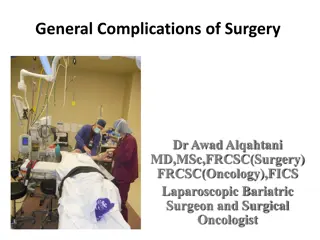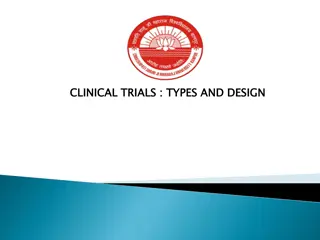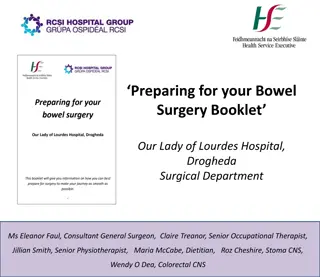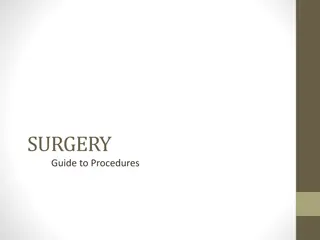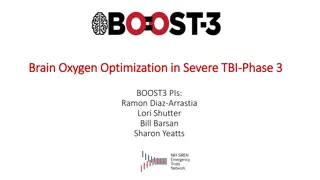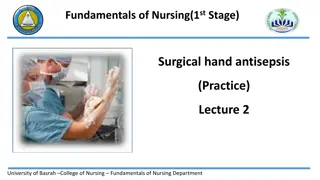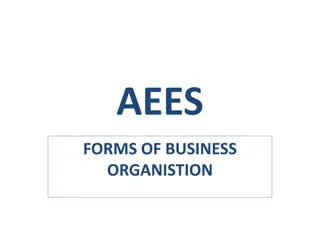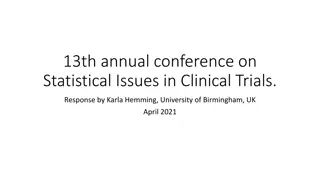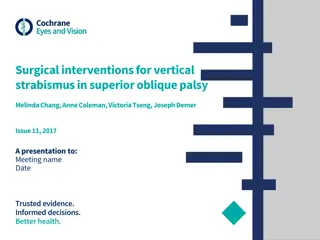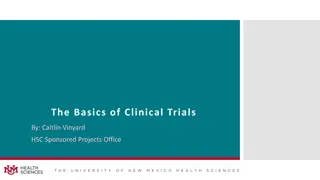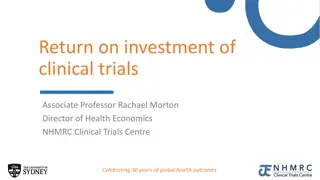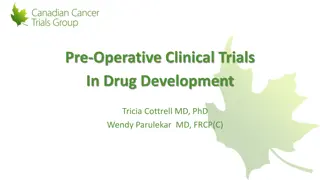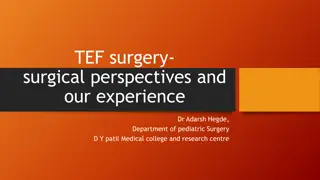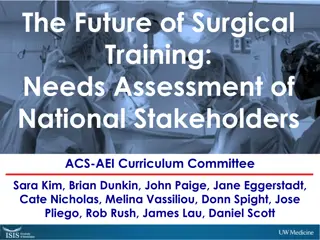
Breakout Session on Pre-Operative Platform Trial for NSCLC Patients
Design a pre-operative platform trial testing novel agents in patients with resectable NSCLC. Explore phase designs, objectives, and safety considerations relevant to therapeutic efficacy testing in this context. Understand the significance of prior therapy, stage, dose, and duration in trial design.
Download Presentation

Please find below an Image/Link to download the presentation.
The content on the website is provided AS IS for your information and personal use only. It may not be sold, licensed, or shared on other websites without obtaining consent from the author. If you encounter any issues during the download, it is possible that the publisher has removed the file from their server.
You are allowed to download the files provided on this website for personal or commercial use, subject to the condition that they are used lawfully. All files are the property of their respective owners.
The content on the website is provided AS IS for your information and personal use only. It may not be sold, licensed, or shared on other websites without obtaining consent from the author.
E N D
Presentation Transcript
Objectives Of Breakout Session Design a pre-operative platform trial testing novel agents in patients with resectable NSCLC Classify: Therapeutic versus non-therapeutic Identify primary and secondary outcome measures 2
1. Which phase design would you select? A. Window of opportunity B. Phase 0 C. Phase 1 D. Phase 2 E. Phase 3 Objective: Design a pre-operative platform trial testing novel agents in patients with resectable NSCLC 3
Disclaimer*: over-simplified, relative to this scenario specifically WOO WOO Phase 0 Phase 0 Phase 1 Phase 1 Phase 2 Phase 2 Phase 3 Phase 3 N Small Small Small Medium Large Prior therapy No Yes Yes No No Safety Shown Yes No No Yes Yes Stage Resectable Advanced Advanced Resectable Resectable Dose Therapeutic Low Escalating Therapeutic Therapeutic Duration Short Short Therapeutic Therapeutic Therapeutic Objective Exploratory Safety Safety Efficacy Efficacy 4 *I m a pathologist .
First-in-human and safety studies generally are NOT done in untreated, early stage patients WOO WOO Phase 0 Phase 0 Phase 1 Phase 1 Phase 2 Phase 2 Phase 3 Phase 3 N Small Small Small Medium Large Prior therapy No Yes Yes No No Safety Shown Yes No No Yes Yes Stage Resectable Advanced Advanced Resectable Resectable Dose Therapeutic Low Escalating Therapeutic Therapeutic Duration Short Short Therapeutic Therapeutic Therapeutic Objective Exploratory Safety Safety Efficacy Efficacy 5
1. Which phase design would you select? A. Window of opportunity B. Phase 0 C. Phase 1 D. Phase 2 E. Phase 3 Objective: Design a pre-operative platform trial testing novel agents in patients with resectable NSCLC 6
Testing for efficacy signals WOO WOO Phase 0 Phase 0 Phase 1 Phase 1 Phase 2 Phase 2 Phase 3 Phase 3 N Small Small Small Medium Large Prior therapy No Yes Yes No No Safety Shown Yes No No Yes Yes Common Stage Resectable Advanced Advanced Resectable Resectable Dose Therapeutic Low Escalating Therapeutic Therapeutic Duration Short Short Therapeutic Therapeutic Therapeutic Objective Exploratory Safety Safety Efficacy Efficacy 7
1. Which phase design would you select? A. Window of opportunity B. Phase 0 C. Phase 1 D. Phase 2 E. Phase 3 Objective: Design a pre-operative platform trial testing novel agents in patients with resectable NSCLC 8
2. Which of the following are benefits of a platform trial design? A. Assumes a heterogeneous patient population B. Allows parallel and sequential testing of novel therapies and combinations C. Trial adapts based on data collected D. Pre-defined criteria for success or failure of a treatment arm E. Speed and cost-efficiency Objective: Design a pre-operative platform novel agents novel agents in patients with resectable NSCLC platform trial testing 9
2. Which of the following are benefits of a platform trial design? A. Assumes a heterogeneous patient population B. Allows parallel and sequential testing of novel therapies and combinations C. Trial adapts based on data collected D. Pre-defined criteria for success or failure of a treatment arm E. Speed and cost-efficiency F. All of the above 10
A platform trial is defined by the broad goal of finding the best treatment for a disease by simultaneously investigating multiple treatments simultaneously investigating multiple treatments, using specialized statistical tools for allocating patients and analyzing results. The focus is on the disease rather than any particular experimental therapy any particular experimental therapy. The focus is on the disease rather than 11 Berry et al. JAMA 2015
3. What are potential pros and cons of using a biomarker-selected population? Objective: Design a pre-operative platform trial testing novel agents in patients with resectable NSCLC 12
3. What are potential pros and cons of using a biomarker-selected population? Pro s May enrich for responders (e.g., positive trial more likely) Reduces risk in patients unlikely to response Support cost-effective care May inform combinatorial therapies/precision therapy Con s Testing costs and complexity (# screen/eligible patient) Slower accrual Testing-related delays in treatment (test-results turnaround) Poor sensitivity (untreated responders) Poor specificity (treated non-responders) 13
4. Which safety considerations are unique to neoadjuvant trials? A. Disease progression B. Surgical complications C. Drug interactions D. Adverse Events E. Delay of surgery or inoperability Objective: Design a pre-operative platform trial testing novel agents in patients with resectable NSCLC 14
4. Which safety considerations are unique to neoadjuvant trials? Potentially curable (resectable) A. Disease progression (Feasibility) B. Surgical complications (Safety) Incurable (unresectable) C. Drug interactions D. Adverse Events E. Delay of surgery or inoperability (Feasibility) 15 *Patients and surgeons need this data
5. If our goal is speedy results, which efficacy outcome measure(s) is/are preferred? A. Event-free survival (EFS) B. Recurrence-free survival (RFS) C. Major pathologic response (MPR) D. Overall survival (OS) E. Pathologic complete response (pCR) Objective: Design a pre-operative platform trial testing novel agents in patients with resectable NSCLC 16
5. If our goal is speedy results, which efficacy endpoint(s) is/are preferred? A. Event-free survival (EFS)* B. Recurrence-free survival (RFS) C. Major pathologic response (MPR) D. Overall survival (OS) E. Pathologic complete response (pCR) Objective: Design a pre-operative platform trial testing novel agents in patients with resectable NSCLC 17
6. Proposed primary and secondary endpoints? Objective: Design a pre-operative platform trial testing novel agents in patients with resectable NSCLC 18
6. Proposed primary and secondary endpoints? Primary Secondary Safety Feasibility *power calculations pCR and MPR EFS at 2 years Surgical outcomes Downstaging Radiologic response Biomarkers Quality of life 19
6. Proposed primary and secondary endpoints? Safety For grade 3 or higher adverse events 30% discontinue arm 10% continue If 3 grade 3 or higher adverse events are observed in 20 patients: treatment is safe. Type I error = 0.11; power = 0.87 with exact binomial test Feasibility Treatment is considered feasible if 85% of patients receive surgery within 4 weeks of completion of 6 weeks of neoadjuvant therapy 20
Objectives To identify role(s) of preoperative trials in cancer drug development Identify key trial elements that guide the design of preoperative trials Design a preoperative platform trial testing novel agents in patients with resectable NSCLC 21
THANK YOU 22



